Case Study: Analyzing Wadula Puzzling Cube's Effectiveness in Nursing
VerifiedAdded on 2023/03/23
|9
|2336
|49
Case Study
AI Summary
This case study explores the effectiveness of the Wadula Puzzling Cube (WPC) as a practice development tool within a nursing context. The student, reflecting on a clinical issue during their nursing education, utilizes the WPC to address a lack of personal protective equipment (gloves) in bed-making procedures. The assignment details the student's process of puzzling the issue, involving collaboration with colleagues and guidance from their mother to reframe the problem. The student employs CIP principles and positive questioning techniques to develop a puzzle statement aimed at persuading hospital administration to provide gloves, thereby supporting practice development and patient-centered care. The case study highlights the WPC's utility in fostering collaborative problem-solving and achieving internal solutions within a healthcare setting, ultimately demonstrating its effectiveness in addressing clinical challenges and promoting positive change. The case study also includes the application of a practice development tool to an issue experienced in healthcare by the student. The student then develops an action plan with short- and long-term goals for project implementation using SMART goals.
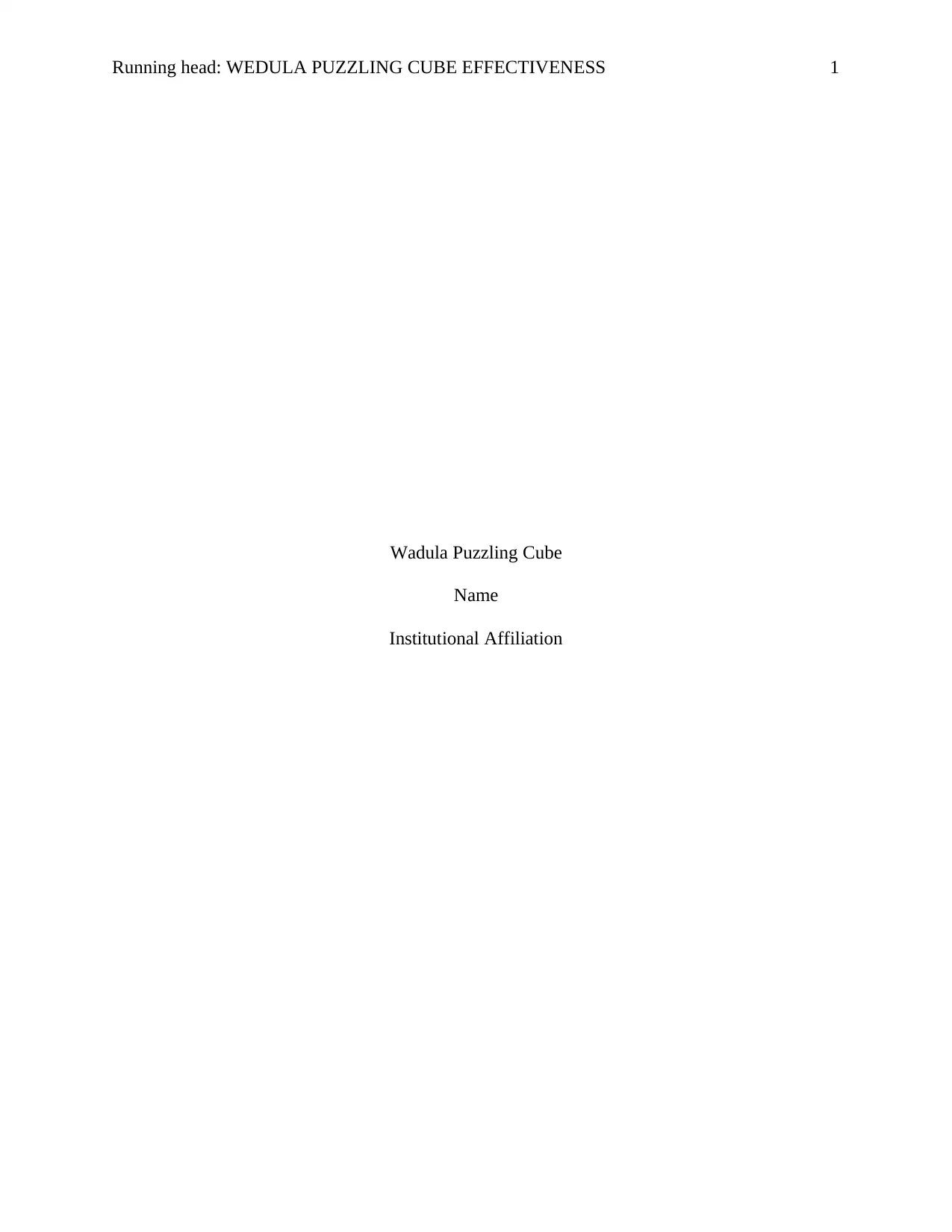
Running head: WEDULA PUZZLING CUBE EFFECTIVENESS 1
Wadula Puzzling Cube
Name
Institutional Affiliation
Wadula Puzzling Cube
Name
Institutional Affiliation
Paraphrase This Document
Need a fresh take? Get an instant paraphrase of this document with our AI Paraphraser
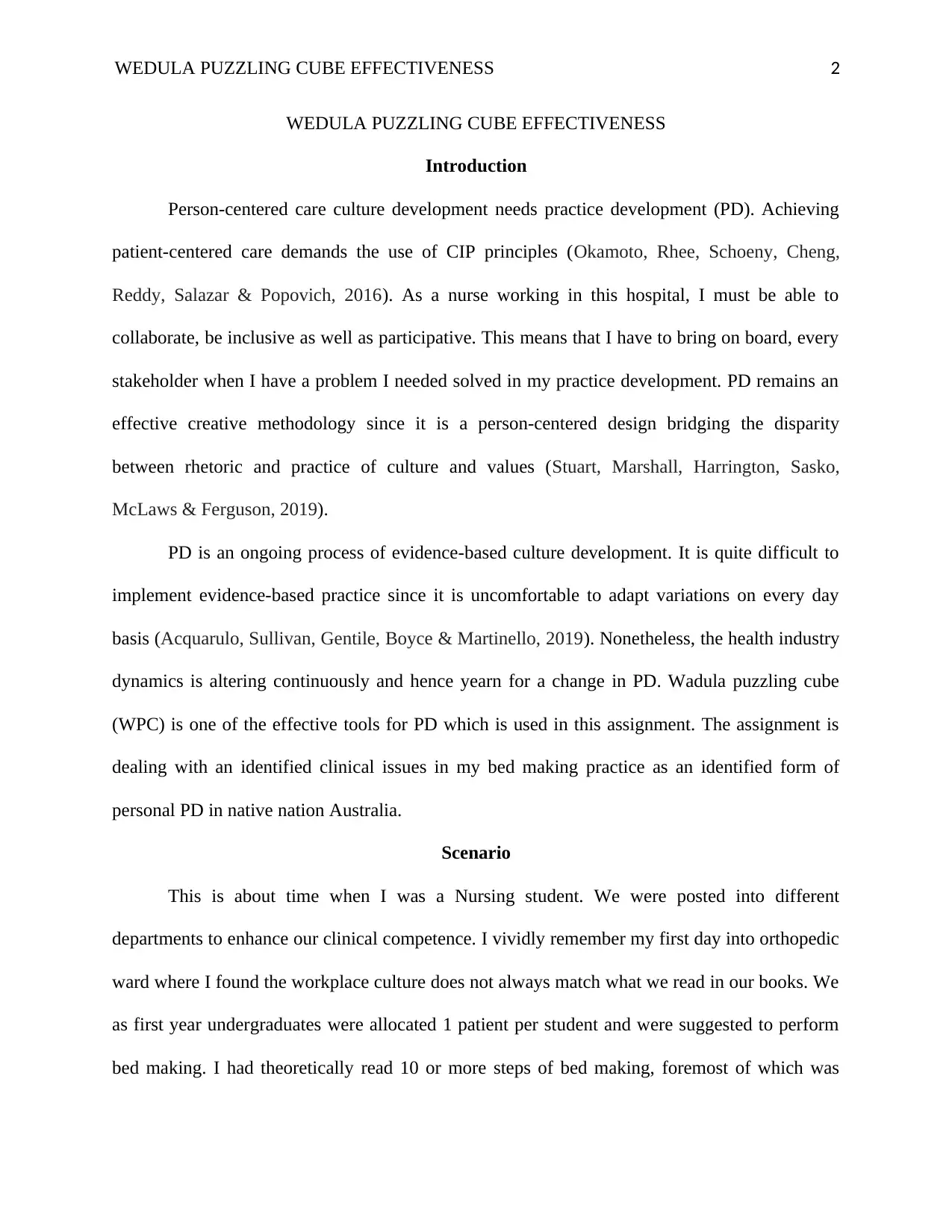
WEDULA PUZZLING CUBE EFFECTIVENESS 2
WEDULA PUZZLING CUBE EFFECTIVENESS
Introduction
Person-centered care culture development needs practice development (PD). Achieving
patient-centered care demands the use of CIP principles (Okamoto, Rhee, Schoeny, Cheng,
Reddy, Salazar & Popovich, 2016). As a nurse working in this hospital, I must be able to
collaborate, be inclusive as well as participative. This means that I have to bring on board, every
stakeholder when I have a problem I needed solved in my practice development. PD remains an
effective creative methodology since it is a person-centered design bridging the disparity
between rhetoric and practice of culture and values (Stuart, Marshall, Harrington, Sasko,
McLaws & Ferguson, 2019).
PD is an ongoing process of evidence-based culture development. It is quite difficult to
implement evidence-based practice since it is uncomfortable to adapt variations on every day
basis (Acquarulo, Sullivan, Gentile, Boyce & Martinello, 2019). Nonetheless, the health industry
dynamics is altering continuously and hence yearn for a change in PD. Wadula puzzling cube
(WPC) is one of the effective tools for PD which is used in this assignment. The assignment is
dealing with an identified clinical issues in my bed making practice as an identified form of
personal PD in native nation Australia.
Scenario
This is about time when I was a Nursing student. We were posted into different
departments to enhance our clinical competence. I vividly remember my first day into orthopedic
ward where I found the workplace culture does not always match what we read in our books. We
as first year undergraduates were allocated 1 patient per student and were suggested to perform
bed making. I had theoretically read 10 or more steps of bed making, foremost of which was
WEDULA PUZZLING CUBE EFFECTIVENESS
Introduction
Person-centered care culture development needs practice development (PD). Achieving
patient-centered care demands the use of CIP principles (Okamoto, Rhee, Schoeny, Cheng,
Reddy, Salazar & Popovich, 2016). As a nurse working in this hospital, I must be able to
collaborate, be inclusive as well as participative. This means that I have to bring on board, every
stakeholder when I have a problem I needed solved in my practice development. PD remains an
effective creative methodology since it is a person-centered design bridging the disparity
between rhetoric and practice of culture and values (Stuart, Marshall, Harrington, Sasko,
McLaws & Ferguson, 2019).
PD is an ongoing process of evidence-based culture development. It is quite difficult to
implement evidence-based practice since it is uncomfortable to adapt variations on every day
basis (Acquarulo, Sullivan, Gentile, Boyce & Martinello, 2019). Nonetheless, the health industry
dynamics is altering continuously and hence yearn for a change in PD. Wadula puzzling cube
(WPC) is one of the effective tools for PD which is used in this assignment. The assignment is
dealing with an identified clinical issues in my bed making practice as an identified form of
personal PD in native nation Australia.
Scenario
This is about time when I was a Nursing student. We were posted into different
departments to enhance our clinical competence. I vividly remember my first day into orthopedic
ward where I found the workplace culture does not always match what we read in our books. We
as first year undergraduates were allocated 1 patient per student and were suggested to perform
bed making. I had theoretically read 10 or more steps of bed making, foremost of which was
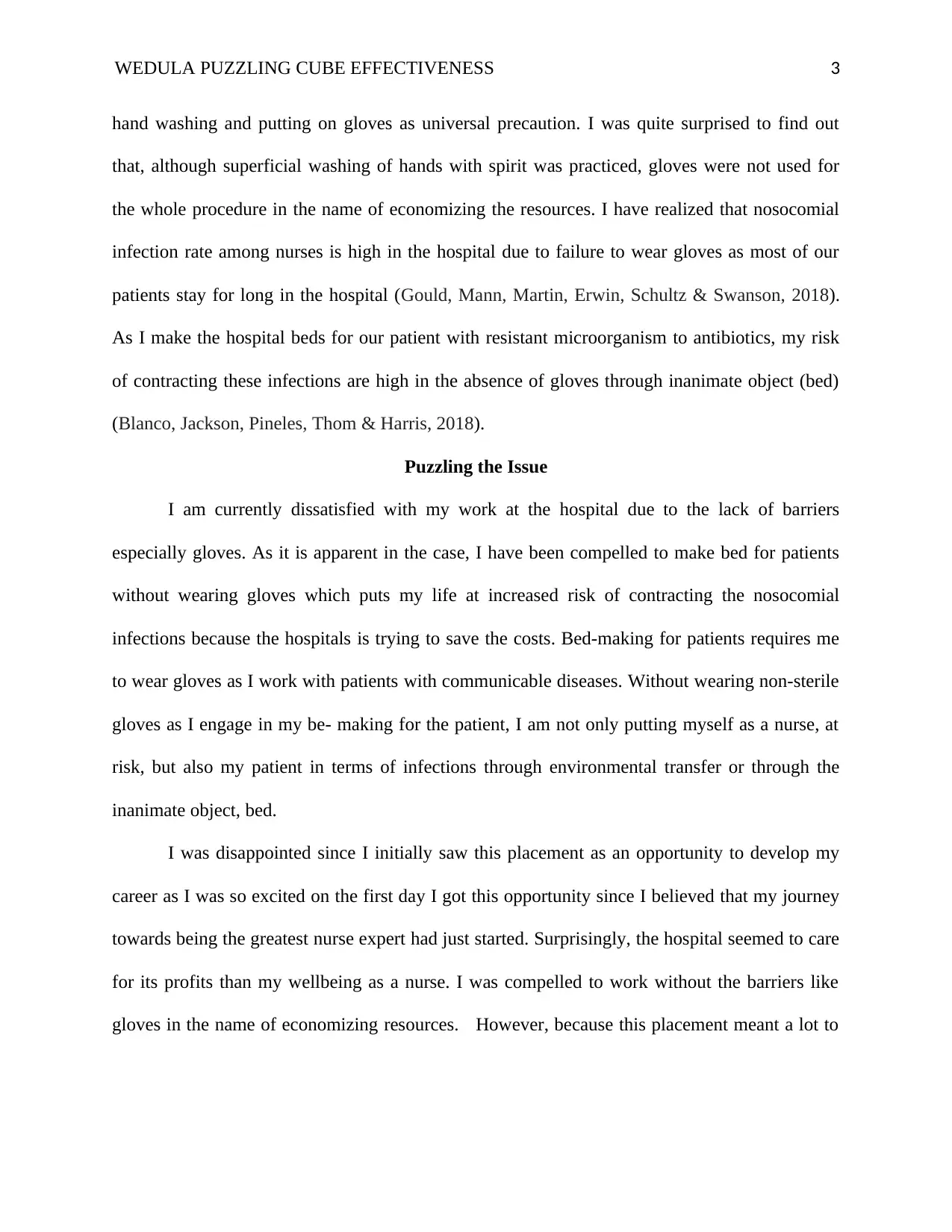
WEDULA PUZZLING CUBE EFFECTIVENESS 3
hand washing and putting on gloves as universal precaution. I was quite surprised to find out
that, although superficial washing of hands with spirit was practiced, gloves were not used for
the whole procedure in the name of economizing the resources. I have realized that nosocomial
infection rate among nurses is high in the hospital due to failure to wear gloves as most of our
patients stay for long in the hospital (Gould, Mann, Martin, Erwin, Schultz & Swanson, 2018).
As I make the hospital beds for our patient with resistant microorganism to antibiotics, my risk
of contracting these infections are high in the absence of gloves through inanimate object (bed)
(Blanco, Jackson, Pineles, Thom & Harris, 2018).
Puzzling the Issue
I am currently dissatisfied with my work at the hospital due to the lack of barriers
especially gloves. As it is apparent in the case, I have been compelled to make bed for patients
without wearing gloves which puts my life at increased risk of contracting the nosocomial
infections because the hospitals is trying to save the costs. Bed-making for patients requires me
to wear gloves as I work with patients with communicable diseases. Without wearing non-sterile
gloves as I engage in my be- making for the patient, I am not only putting myself as a nurse, at
risk, but also my patient in terms of infections through environmental transfer or through the
inanimate object, bed.
I was disappointed since I initially saw this placement as an opportunity to develop my
career as I was so excited on the first day I got this opportunity since I believed that my journey
towards being the greatest nurse expert had just started. Surprisingly, the hospital seemed to care
for its profits than my wellbeing as a nurse. I was compelled to work without the barriers like
gloves in the name of economizing resources. However, because this placement meant a lot to
hand washing and putting on gloves as universal precaution. I was quite surprised to find out
that, although superficial washing of hands with spirit was practiced, gloves were not used for
the whole procedure in the name of economizing the resources. I have realized that nosocomial
infection rate among nurses is high in the hospital due to failure to wear gloves as most of our
patients stay for long in the hospital (Gould, Mann, Martin, Erwin, Schultz & Swanson, 2018).
As I make the hospital beds for our patient with resistant microorganism to antibiotics, my risk
of contracting these infections are high in the absence of gloves through inanimate object (bed)
(Blanco, Jackson, Pineles, Thom & Harris, 2018).
Puzzling the Issue
I am currently dissatisfied with my work at the hospital due to the lack of barriers
especially gloves. As it is apparent in the case, I have been compelled to make bed for patients
without wearing gloves which puts my life at increased risk of contracting the nosocomial
infections because the hospitals is trying to save the costs. Bed-making for patients requires me
to wear gloves as I work with patients with communicable diseases. Without wearing non-sterile
gloves as I engage in my be- making for the patient, I am not only putting myself as a nurse, at
risk, but also my patient in terms of infections through environmental transfer or through the
inanimate object, bed.
I was disappointed since I initially saw this placement as an opportunity to develop my
career as I was so excited on the first day I got this opportunity since I believed that my journey
towards being the greatest nurse expert had just started. Surprisingly, the hospital seemed to care
for its profits than my wellbeing as a nurse. I was compelled to work without the barriers like
gloves in the name of economizing resources. However, because this placement meant a lot to
⊘ This is a preview!⊘
Do you want full access?
Subscribe today to unlock all pages.

Trusted by 1+ million students worldwide
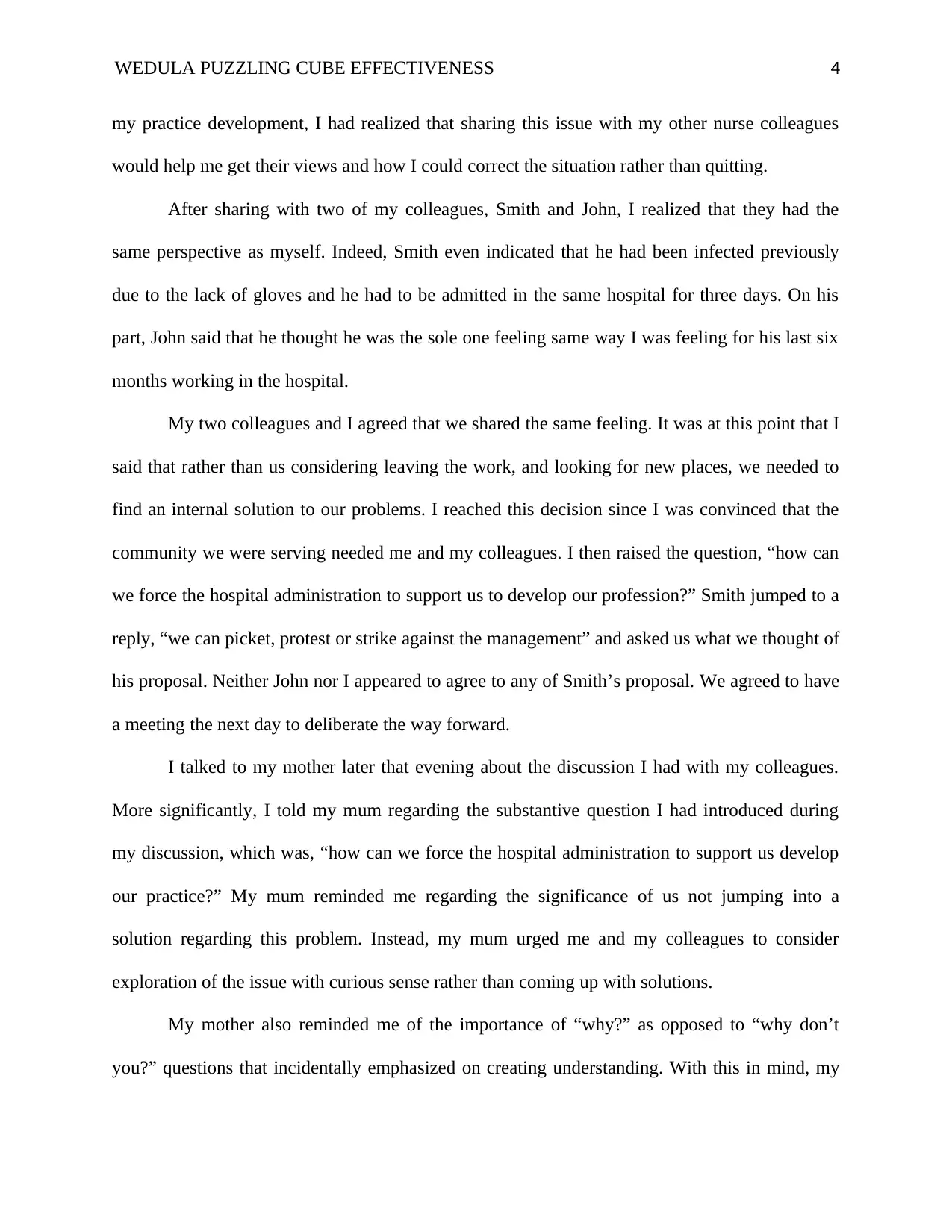
WEDULA PUZZLING CUBE EFFECTIVENESS 4
my practice development, I had realized that sharing this issue with my other nurse colleagues
would help me get their views and how I could correct the situation rather than quitting.
After sharing with two of my colleagues, Smith and John, I realized that they had the
same perspective as myself. Indeed, Smith even indicated that he had been infected previously
due to the lack of gloves and he had to be admitted in the same hospital for three days. On his
part, John said that he thought he was the sole one feeling same way I was feeling for his last six
months working in the hospital.
My two colleagues and I agreed that we shared the same feeling. It was at this point that I
said that rather than us considering leaving the work, and looking for new places, we needed to
find an internal solution to our problems. I reached this decision since I was convinced that the
community we were serving needed me and my colleagues. I then raised the question, “how can
we force the hospital administration to support us to develop our profession?” Smith jumped to a
reply, “we can picket, protest or strike against the management” and asked us what we thought of
his proposal. Neither John nor I appeared to agree to any of Smith’s proposal. We agreed to have
a meeting the next day to deliberate the way forward.
I talked to my mother later that evening about the discussion I had with my colleagues.
More significantly, I told my mum regarding the substantive question I had introduced during
my discussion, which was, “how can we force the hospital administration to support us develop
our practice?” My mum reminded me regarding the significance of us not jumping into a
solution regarding this problem. Instead, my mum urged me and my colleagues to consider
exploration of the issue with curious sense rather than coming up with solutions.
My mother also reminded me of the importance of “why?” as opposed to “why don’t
you?” questions that incidentally emphasized on creating understanding. With this in mind, my
my practice development, I had realized that sharing this issue with my other nurse colleagues
would help me get their views and how I could correct the situation rather than quitting.
After sharing with two of my colleagues, Smith and John, I realized that they had the
same perspective as myself. Indeed, Smith even indicated that he had been infected previously
due to the lack of gloves and he had to be admitted in the same hospital for three days. On his
part, John said that he thought he was the sole one feeling same way I was feeling for his last six
months working in the hospital.
My two colleagues and I agreed that we shared the same feeling. It was at this point that I
said that rather than us considering leaving the work, and looking for new places, we needed to
find an internal solution to our problems. I reached this decision since I was convinced that the
community we were serving needed me and my colleagues. I then raised the question, “how can
we force the hospital administration to support us to develop our profession?” Smith jumped to a
reply, “we can picket, protest or strike against the management” and asked us what we thought of
his proposal. Neither John nor I appeared to agree to any of Smith’s proposal. We agreed to have
a meeting the next day to deliberate the way forward.
I talked to my mother later that evening about the discussion I had with my colleagues.
More significantly, I told my mum regarding the substantive question I had introduced during
my discussion, which was, “how can we force the hospital administration to support us develop
our practice?” My mum reminded me regarding the significance of us not jumping into a
solution regarding this problem. Instead, my mum urged me and my colleagues to consider
exploration of the issue with curious sense rather than coming up with solutions.
My mother also reminded me of the importance of “why?” as opposed to “why don’t
you?” questions that incidentally emphasized on creating understanding. With this in mind, my
Paraphrase This Document
Need a fresh take? Get an instant paraphrase of this document with our AI Paraphraser
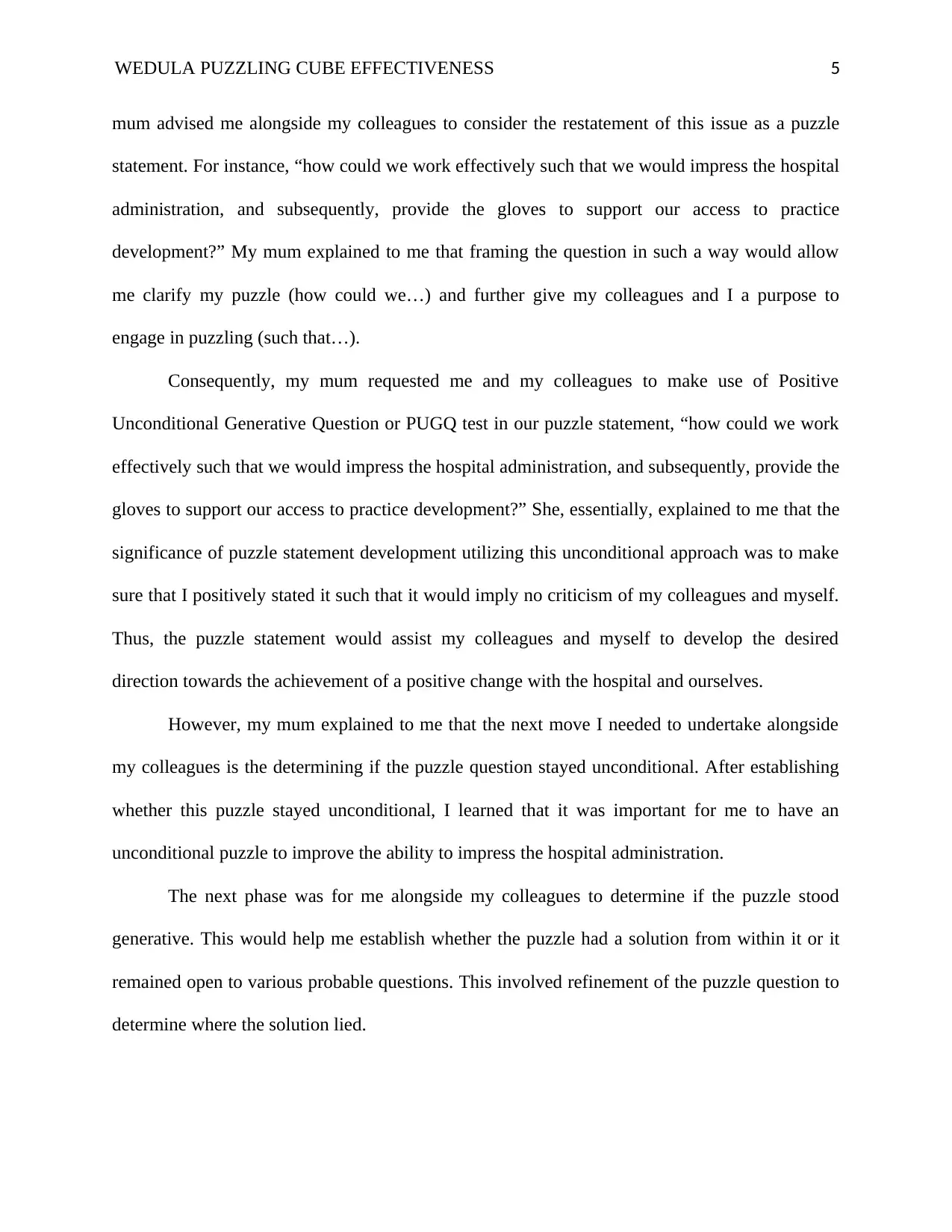
WEDULA PUZZLING CUBE EFFECTIVENESS 5
mum advised me alongside my colleagues to consider the restatement of this issue as a puzzle
statement. For instance, “how could we work effectively such that we would impress the hospital
administration, and subsequently, provide the gloves to support our access to practice
development?” My mum explained to me that framing the question in such a way would allow
me clarify my puzzle (how could we…) and further give my colleagues and I a purpose to
engage in puzzling (such that…).
Consequently, my mum requested me and my colleagues to make use of Positive
Unconditional Generative Question or PUGQ test in our puzzle statement, “how could we work
effectively such that we would impress the hospital administration, and subsequently, provide the
gloves to support our access to practice development?” She, essentially, explained to me that the
significance of puzzle statement development utilizing this unconditional approach was to make
sure that I positively stated it such that it would imply no criticism of my colleagues and myself.
Thus, the puzzle statement would assist my colleagues and myself to develop the desired
direction towards the achievement of a positive change with the hospital and ourselves.
However, my mum explained to me that the next move I needed to undertake alongside
my colleagues is the determining if the puzzle question stayed unconditional. After establishing
whether this puzzle stayed unconditional, I learned that it was important for me to have an
unconditional puzzle to improve the ability to impress the hospital administration.
The next phase was for me alongside my colleagues to determine if the puzzle stood
generative. This would help me establish whether the puzzle had a solution from within it or it
remained open to various probable questions. This involved refinement of the puzzle question to
determine where the solution lied.
mum advised me alongside my colleagues to consider the restatement of this issue as a puzzle
statement. For instance, “how could we work effectively such that we would impress the hospital
administration, and subsequently, provide the gloves to support our access to practice
development?” My mum explained to me that framing the question in such a way would allow
me clarify my puzzle (how could we…) and further give my colleagues and I a purpose to
engage in puzzling (such that…).
Consequently, my mum requested me and my colleagues to make use of Positive
Unconditional Generative Question or PUGQ test in our puzzle statement, “how could we work
effectively such that we would impress the hospital administration, and subsequently, provide the
gloves to support our access to practice development?” She, essentially, explained to me that the
significance of puzzle statement development utilizing this unconditional approach was to make
sure that I positively stated it such that it would imply no criticism of my colleagues and myself.
Thus, the puzzle statement would assist my colleagues and myself to develop the desired
direction towards the achievement of a positive change with the hospital and ourselves.
However, my mum explained to me that the next move I needed to undertake alongside
my colleagues is the determining if the puzzle question stayed unconditional. After establishing
whether this puzzle stayed unconditional, I learned that it was important for me to have an
unconditional puzzle to improve the ability to impress the hospital administration.
The next phase was for me alongside my colleagues to determine if the puzzle stood
generative. This would help me establish whether the puzzle had a solution from within it or it
remained open to various probable questions. This involved refinement of the puzzle question to
determine where the solution lied.
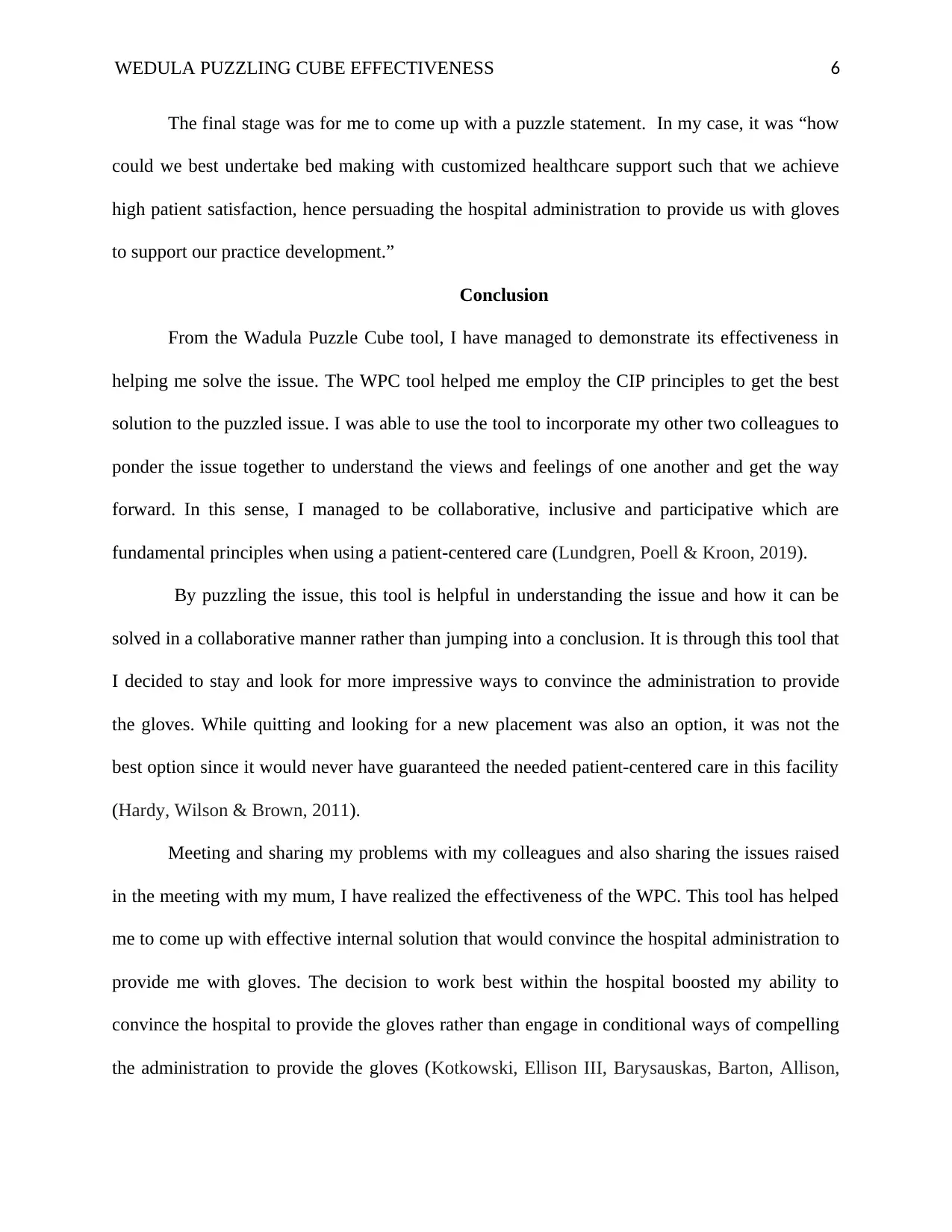
WEDULA PUZZLING CUBE EFFECTIVENESS 6
The final stage was for me to come up with a puzzle statement. In my case, it was “how
could we best undertake bed making with customized healthcare support such that we achieve
high patient satisfaction, hence persuading the hospital administration to provide us with gloves
to support our practice development.”
Conclusion
From the Wadula Puzzle Cube tool, I have managed to demonstrate its effectiveness in
helping me solve the issue. The WPC tool helped me employ the CIP principles to get the best
solution to the puzzled issue. I was able to use the tool to incorporate my other two colleagues to
ponder the issue together to understand the views and feelings of one another and get the way
forward. In this sense, I managed to be collaborative, inclusive and participative which are
fundamental principles when using a patient-centered care (Lundgren, Poell & Kroon, 2019).
By puzzling the issue, this tool is helpful in understanding the issue and how it can be
solved in a collaborative manner rather than jumping into a conclusion. It is through this tool that
I decided to stay and look for more impressive ways to convince the administration to provide
the gloves. While quitting and looking for a new placement was also an option, it was not the
best option since it would never have guaranteed the needed patient-centered care in this facility
(Hardy, Wilson & Brown, 2011).
Meeting and sharing my problems with my colleagues and also sharing the issues raised
in the meeting with my mum, I have realized the effectiveness of the WPC. This tool has helped
me to come up with effective internal solution that would convince the hospital administration to
provide me with gloves. The decision to work best within the hospital boosted my ability to
convince the hospital to provide the gloves rather than engage in conditional ways of compelling
the administration to provide the gloves (Kotkowski, Ellison III, Barysauskas, Barton, Allison,
The final stage was for me to come up with a puzzle statement. In my case, it was “how
could we best undertake bed making with customized healthcare support such that we achieve
high patient satisfaction, hence persuading the hospital administration to provide us with gloves
to support our practice development.”
Conclusion
From the Wadula Puzzle Cube tool, I have managed to demonstrate its effectiveness in
helping me solve the issue. The WPC tool helped me employ the CIP principles to get the best
solution to the puzzled issue. I was able to use the tool to incorporate my other two colleagues to
ponder the issue together to understand the views and feelings of one another and get the way
forward. In this sense, I managed to be collaborative, inclusive and participative which are
fundamental principles when using a patient-centered care (Lundgren, Poell & Kroon, 2019).
By puzzling the issue, this tool is helpful in understanding the issue and how it can be
solved in a collaborative manner rather than jumping into a conclusion. It is through this tool that
I decided to stay and look for more impressive ways to convince the administration to provide
the gloves. While quitting and looking for a new placement was also an option, it was not the
best option since it would never have guaranteed the needed patient-centered care in this facility
(Hardy, Wilson & Brown, 2011).
Meeting and sharing my problems with my colleagues and also sharing the issues raised
in the meeting with my mum, I have realized the effectiveness of the WPC. This tool has helped
me to come up with effective internal solution that would convince the hospital administration to
provide me with gloves. The decision to work best within the hospital boosted my ability to
convince the hospital to provide the gloves rather than engage in conditional ways of compelling
the administration to provide the gloves (Kotkowski, Ellison III, Barysauskas, Barton, Allison,
⊘ This is a preview!⊘
Do you want full access?
Subscribe today to unlock all pages.

Trusted by 1+ million students worldwide
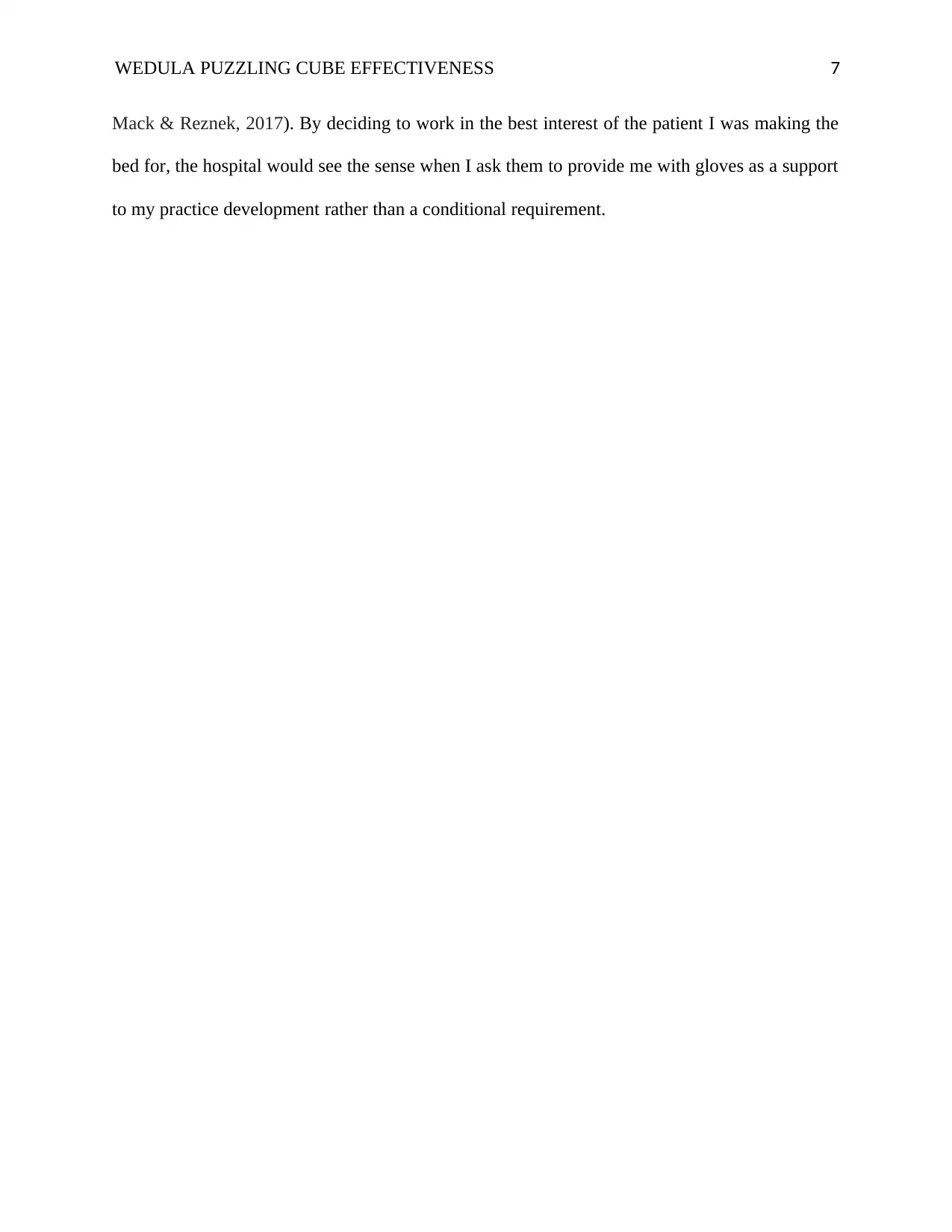
WEDULA PUZZLING CUBE EFFECTIVENESS 7
Mack & Reznek, 2017). By deciding to work in the best interest of the patient I was making the
bed for, the hospital would see the sense when I ask them to provide me with gloves as a support
to my practice development rather than a conditional requirement.
Mack & Reznek, 2017). By deciding to work in the best interest of the patient I was making the
bed for, the hospital would see the sense when I ask them to provide me with gloves as a support
to my practice development rather than a conditional requirement.
Paraphrase This Document
Need a fresh take? Get an instant paraphrase of this document with our AI Paraphraser
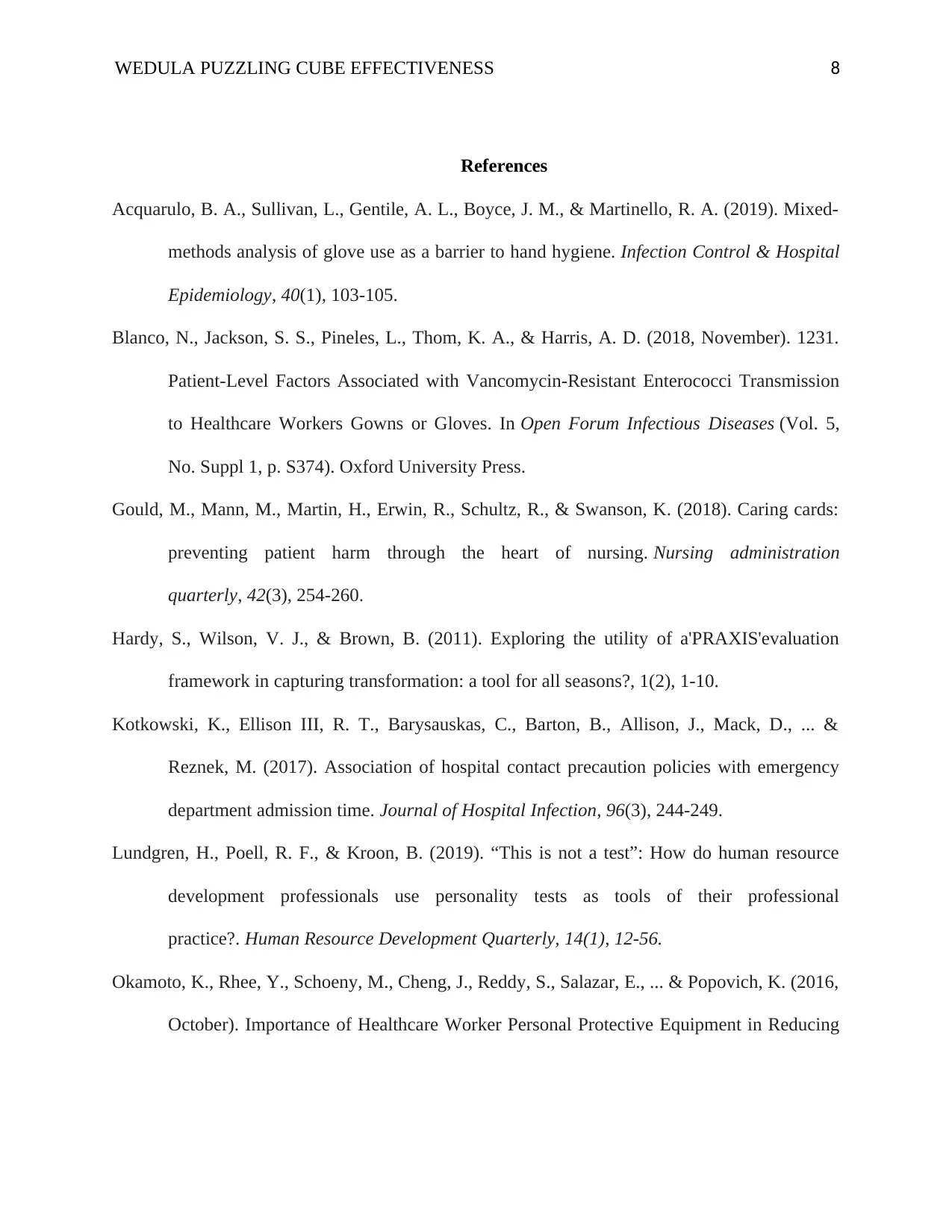
WEDULA PUZZLING CUBE EFFECTIVENESS 8
References
Acquarulo, B. A., Sullivan, L., Gentile, A. L., Boyce, J. M., & Martinello, R. A. (2019). Mixed-
methods analysis of glove use as a barrier to hand hygiene. Infection Control & Hospital
Epidemiology, 40(1), 103-105.
Blanco, N., Jackson, S. S., Pineles, L., Thom, K. A., & Harris, A. D. (2018, November). 1231.
Patient-Level Factors Associated with Vancomycin-Resistant Enterococci Transmission
to Healthcare Workers Gowns or Gloves. In Open Forum Infectious Diseases (Vol. 5,
No. Suppl 1, p. S374). Oxford University Press.
Gould, M., Mann, M., Martin, H., Erwin, R., Schultz, R., & Swanson, K. (2018). Caring cards:
preventing patient harm through the heart of nursing. Nursing administration
quarterly, 42(3), 254-260.
Hardy, S., Wilson, V. J., & Brown, B. (2011). Exploring the utility of a'PRAXIS'evaluation
framework in capturing transformation: a tool for all seasons?, 1(2), 1-10.
Kotkowski, K., Ellison III, R. T., Barysauskas, C., Barton, B., Allison, J., Mack, D., ... &
Reznek, M. (2017). Association of hospital contact precaution policies with emergency
department admission time. Journal of Hospital Infection, 96(3), 244-249.
Lundgren, H., Poell, R. F., & Kroon, B. (2019). “This is not a test”: How do human resource
development professionals use personality tests as tools of their professional
practice?. Human Resource Development Quarterly, 14(1), 12-56.
Okamoto, K., Rhee, Y., Schoeny, M., Cheng, J., Reddy, S., Salazar, E., ... & Popovich, K. (2016,
October). Importance of Healthcare Worker Personal Protective Equipment in Reducing
References
Acquarulo, B. A., Sullivan, L., Gentile, A. L., Boyce, J. M., & Martinello, R. A. (2019). Mixed-
methods analysis of glove use as a barrier to hand hygiene. Infection Control & Hospital
Epidemiology, 40(1), 103-105.
Blanco, N., Jackson, S. S., Pineles, L., Thom, K. A., & Harris, A. D. (2018, November). 1231.
Patient-Level Factors Associated with Vancomycin-Resistant Enterococci Transmission
to Healthcare Workers Gowns or Gloves. In Open Forum Infectious Diseases (Vol. 5,
No. Suppl 1, p. S374). Oxford University Press.
Gould, M., Mann, M., Martin, H., Erwin, R., Schultz, R., & Swanson, K. (2018). Caring cards:
preventing patient harm through the heart of nursing. Nursing administration
quarterly, 42(3), 254-260.
Hardy, S., Wilson, V. J., & Brown, B. (2011). Exploring the utility of a'PRAXIS'evaluation
framework in capturing transformation: a tool for all seasons?, 1(2), 1-10.
Kotkowski, K., Ellison III, R. T., Barysauskas, C., Barton, B., Allison, J., Mack, D., ... &
Reznek, M. (2017). Association of hospital contact precaution policies with emergency
department admission time. Journal of Hospital Infection, 96(3), 244-249.
Lundgren, H., Poell, R. F., & Kroon, B. (2019). “This is not a test”: How do human resource
development professionals use personality tests as tools of their professional
practice?. Human Resource Development Quarterly, 14(1), 12-56.
Okamoto, K., Rhee, Y., Schoeny, M., Cheng, J., Reddy, S., Salazar, E., ... & Popovich, K. (2016,
October). Importance of Healthcare Worker Personal Protective Equipment in Reducing
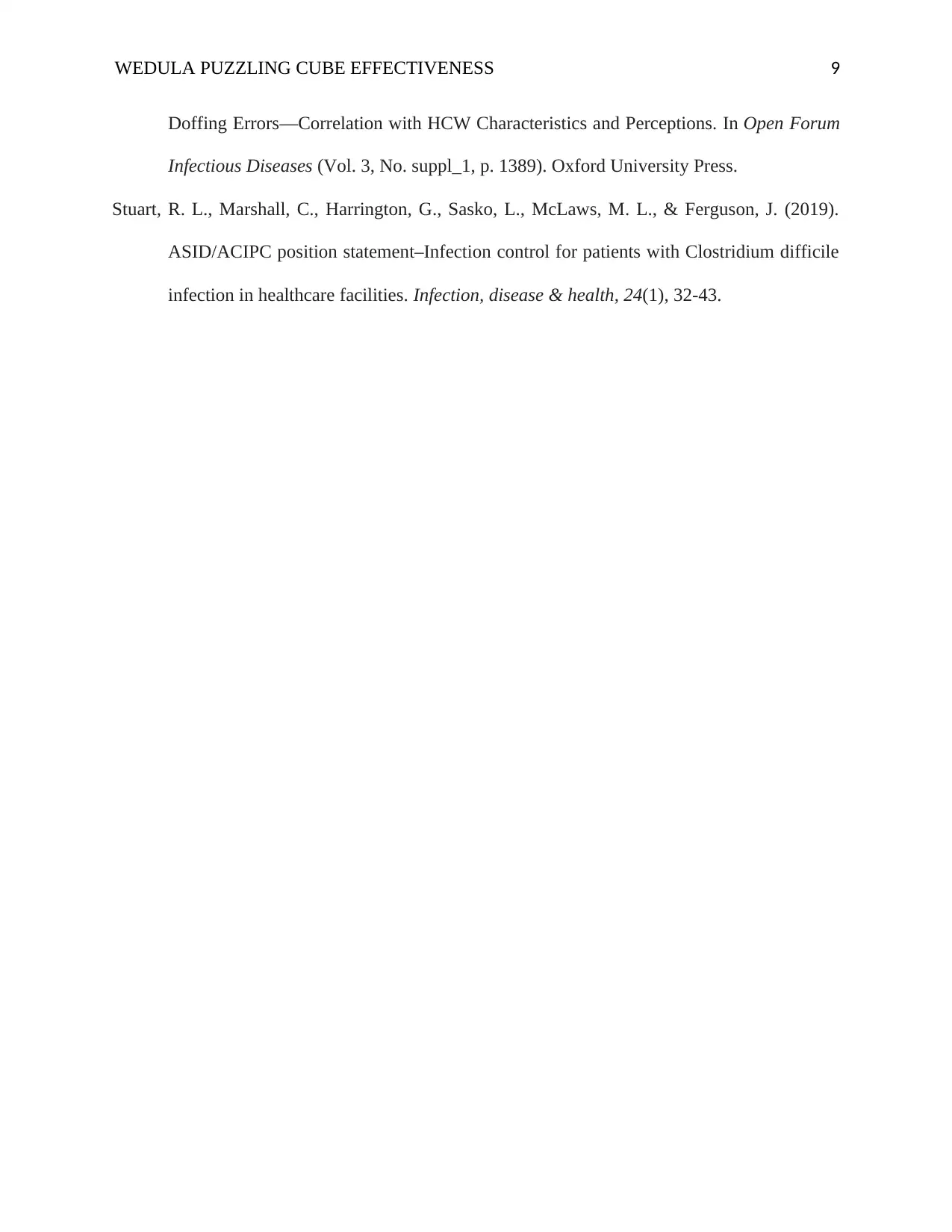
WEDULA PUZZLING CUBE EFFECTIVENESS 9
Doffing Errors—Correlation with HCW Characteristics and Perceptions. In Open Forum
Infectious Diseases (Vol. 3, No. suppl_1, p. 1389). Oxford University Press.
Stuart, R. L., Marshall, C., Harrington, G., Sasko, L., McLaws, M. L., & Ferguson, J. (2019).
ASID/ACIPC position statement–Infection control for patients with Clostridium difficile
infection in healthcare facilities. Infection, disease & health, 24(1), 32-43.
Doffing Errors—Correlation with HCW Characteristics and Perceptions. In Open Forum
Infectious Diseases (Vol. 3, No. suppl_1, p. 1389). Oxford University Press.
Stuart, R. L., Marshall, C., Harrington, G., Sasko, L., McLaws, M. L., & Ferguson, J. (2019).
ASID/ACIPC position statement–Infection control for patients with Clostridium difficile
infection in healthcare facilities. Infection, disease & health, 24(1), 32-43.
⊘ This is a preview!⊘
Do you want full access?
Subscribe today to unlock all pages.

Trusted by 1+ million students worldwide
1 out of 9
Related Documents
Your All-in-One AI-Powered Toolkit for Academic Success.
+13062052269
info@desklib.com
Available 24*7 on WhatsApp / Email
![[object Object]](/_next/static/media/star-bottom.7253800d.svg)
Unlock your academic potential
Copyright © 2020–2025 A2Z Services. All Rights Reserved. Developed and managed by ZUCOL.





